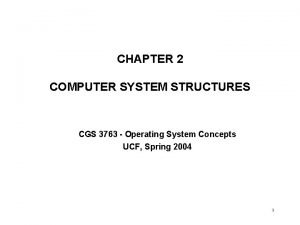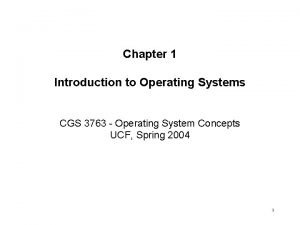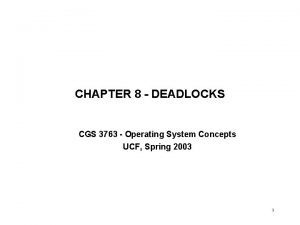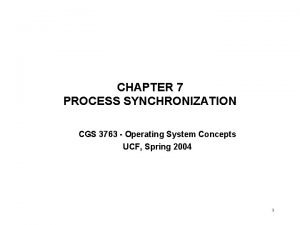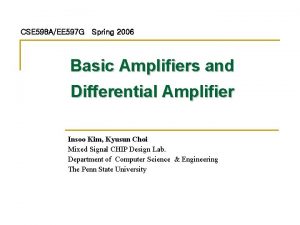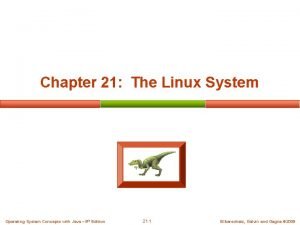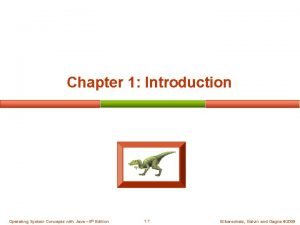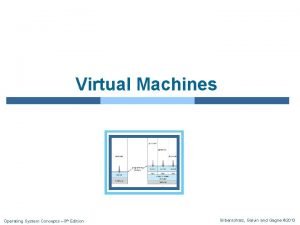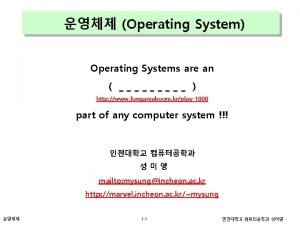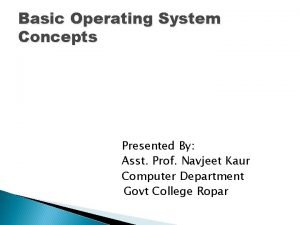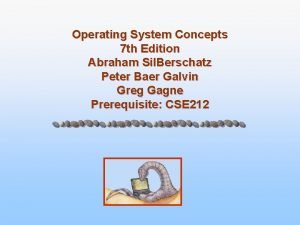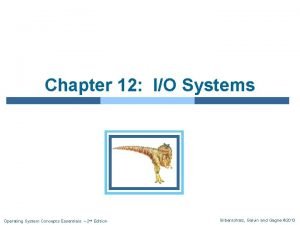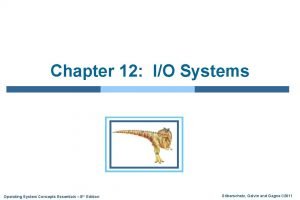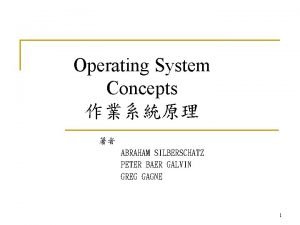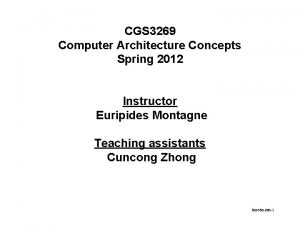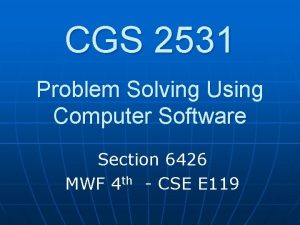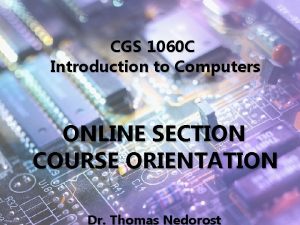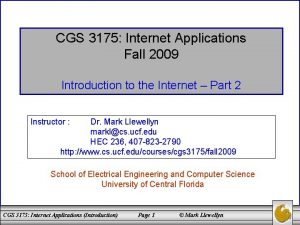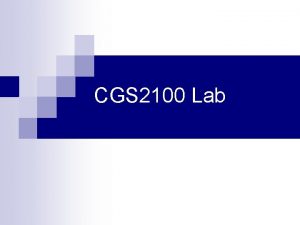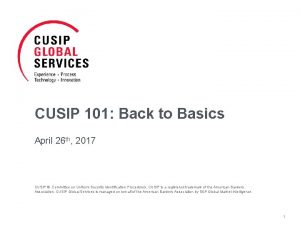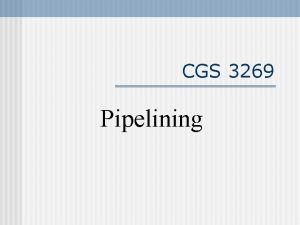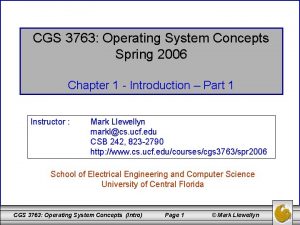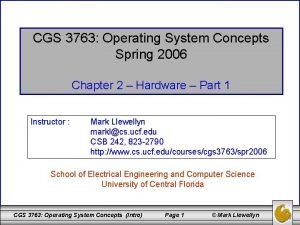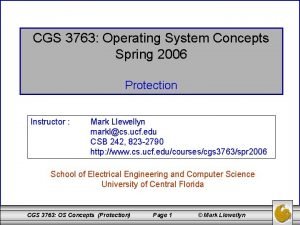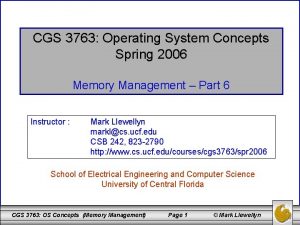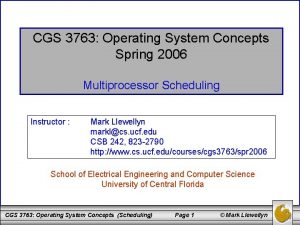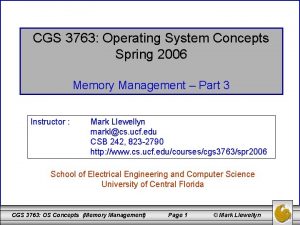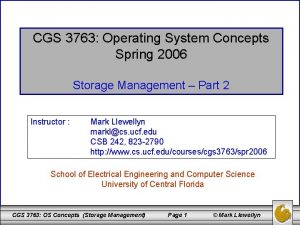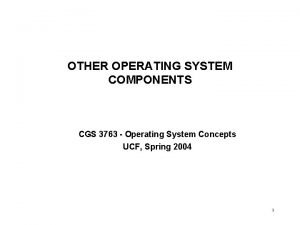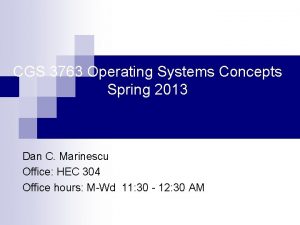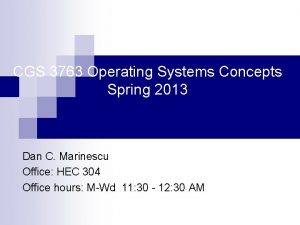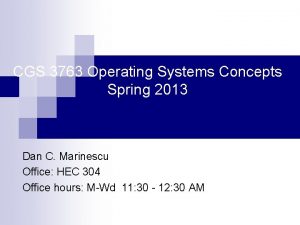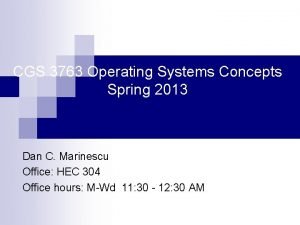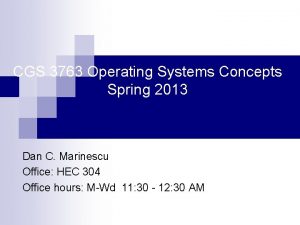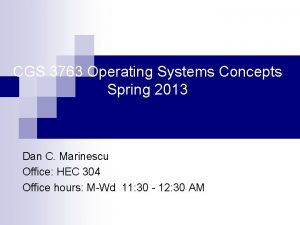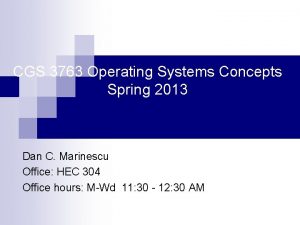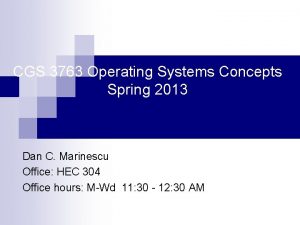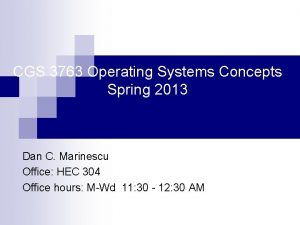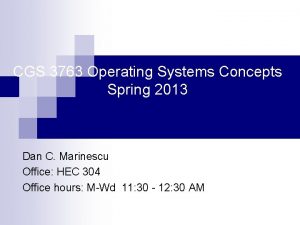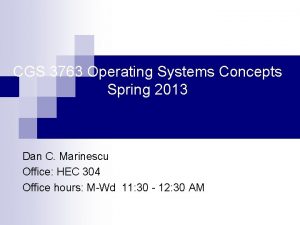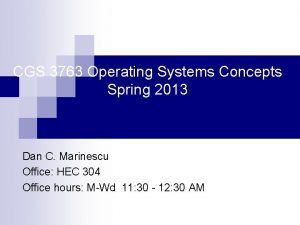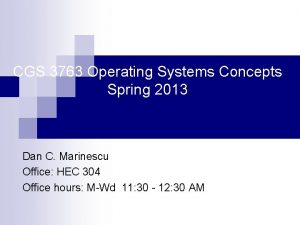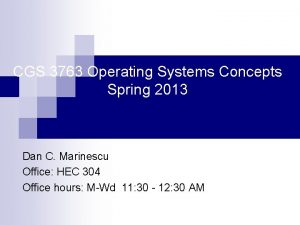CGS 3763 Operating System Concepts Spring 2006 Chapter
































- Slides: 32

CGS 3763: Operating System Concepts Spring 2006 Chapter 2 – Hardware – Part 2 Instructor : Mark Llewellyn markl@cs. ucf. edu CSB 242, 823 -2790 http: //www. cs. ucf. edu/courses/cgs 3763/spr 2006 School of Electrical Engineering and Computer Science University of Central Florida CGS 3763: Operating System Concepts (Chapter 2) Page 1 © Mark Llewellyn

Interrupts • Interrupt the normal sequencing of the processor • Most I/O devices are slower than the processor – Processor must pause to wait for device CGS 3763: Operating System Concepts (Chapter 2) Page 2 © Mark Llewellyn

Classes of Interrupts CGS 3763: Operating System Concepts (Chapter 2) Page 3 © Mark Llewellyn

Program Flow of Control Without Interrupts CGS 3763: Operating System Concepts (Chapter 2) Page 4 © Mark Llewellyn

Program Flow of Control With Interrupts, Short I/O Wait CGS 3763: Operating System Concepts (Chapter 2) Page 5 © Mark Llewellyn

Program Flow of Control With Interrupts; Long I/O Wait CGS 3763: Operating System Concepts (Chapter 2) Page 6 © Mark Llewellyn

Interrupt Handler • Program to service a particular I/O device • Generally part of the operating system CGS 3763: Operating System Concepts (Chapter 2) Page 7 © Mark Llewellyn

Interrupts • Suspends the normal sequence of execution CGS 3763: Operating System Concepts (Chapter 2) Page 8 © Mark Llewellyn

Interrupt Cycle CGS 3763: Operating System Concepts (Chapter 2) Page 9 © Mark Llewellyn

Interrupt Cycle • Processor checks for interrupts • If no interrupts fetch the next instruction for the current program • If an interrupt is pending, suspend execution of the current program, and execute the interrupt-handler routine CGS 3763: Operating System Concepts (Chapter 2) Page 10 © Mark Llewellyn

Timing Diagram Based on Short I/O Wait Numbers refer to page 5 Numbers refer to page 4 CGS 3763: Operating System Concepts (Chapter 2) Page 11 © Mark Llewellyn

Timing Diagram Based on Long I/O Wait Numbers refer to page 6 Numbers refer to page 4 CGS 3763: Operating System Concepts (Chapter 2) Page 12 © Mark Llewellyn

Simple Interrupt Processing CGS 3763: Operating System Concepts (Chapter 2) Page 13 © Mark Llewellyn

Changes in Memory and Registers for an Interrupt CGS 3763: Operating System Concepts (Chapter 2) Page 14 © Mark Llewellyn

Changes in Memory and Registers for an Interrupt CGS 3763: Operating System Concepts (Chapter 2) Page 15 © Mark Llewellyn

Multiple Interrupts • Disable interrupts while an interrupt is being processed CGS 3763: Operating System Concepts (Chapter 2) Page 16 © Mark Llewellyn

Multiple Interrupts • Define priorities for interrupts CGS 3763: Operating System Concepts (Chapter 2) Page 17 © Mark Llewellyn

Multiple Interrupts CGS 3763: Operating System Concepts (Chapter 2) Page 18 © Mark Llewellyn

Multiprogramming • Processor has more than one program to execute • The sequence the programs are executed depend on their relative priority and whether they are waiting for I/O • After an interrupt handler completes, control may not return to the program that was executing at the time of the interrupt CGS 3763: Operating System Concepts (Chapter 2) Page 19 © Mark Llewellyn

Memory Hierarchy • Faster access time, greater cost per bit • Greater capacity, smaller cost per bit • Greater capacity, slower access speed CGS 3763: Operating System Concepts (Chapter 2) Page 20 © Mark Llewellyn

Disk Cache • A portion of main memory used as a buffer to temporarily to hold data for the disk • Disk writes are clustered • Some data written out may be referenced again. The data are retrieved rapidly from the software cache instead of slowly from disk CGS 3763: Operating System Concepts (Chapter 2) Page 21 © Mark Llewellyn

Cache Memory • • Invisible to operating system Increase the speed of memory Processor speed is faster than memory speed Exploit the principle of locality CGS 3763: Operating System Concepts (Chapter 2) Page 22 © Mark Llewellyn

Cache Memory CGS 3763: Operating System Concepts (Chapter 2) Page 23 © Mark Llewellyn

Cache Memory • Contains a copy of a portion of main memory • Processor first checks cache • If not found in cache, the block of memory containing the needed information is moved to the cache and delivered to the processor CGS 3763: Operating System Concepts (Chapter 2) Page 24 © Mark Llewellyn

Cache/Main Memory System CGS 3763: Operating System Concepts (Chapter 2) Page 25 © Mark Llewellyn

Cache Read Operation CGS 3763: Operating System Concepts (Chapter 2) Page 26 © Mark Llewellyn

Cache Design • Cache size – Small caches have a significant impact on performance • Block size – The unit of data exchanged between cache and main memory – Larger block size more hits until probability of using newly fetched data becomes less than the probability of reusing data that have to be moved out of cache CGS 3763: Operating System Concepts (Chapter 2) Page 27 © Mark Llewellyn

Cache Design • Mapping function – Determines which cache location the block will occupy • Replacement algorithm – Determines which block to replace – Least-Recently-Used (LRU) algorithm CGS 3763: Operating System Concepts (Chapter 2) Page 28 © Mark Llewellyn

Cache Design • Write policy – When the memory write operation takes place – Can occur every time block is updated – Can occur only when block is replaced • Minimizes memory write operations • Leaves main memory in an obsolete state CGS 3763: Operating System Concepts (Chapter 2) Page 29 © Mark Llewellyn

Programmed I/O • I/O module performs the action, not the processor • Sets appropriate bits in the I/O status register • No interrupts occur • Processor checks status until operation is complete CGS 3763: Operating System Concepts (Chapter 2) Page 30 © Mark Llewellyn

Interrupt-Driven I/O • Processor is interrupted when I/O module ready to exchange data • Processor saves context of program executing and begins executing interrupt-handler • No needless waiting • Consumes a lot of processor time because every word read or written passes through the processor CGS 3763: Operating System Concepts (Chapter 2) Page 31 © Mark Llewellyn

Direct Memory Access • Transfers a block of data directly to or from memory • An interrupt is sent when the transfer is complete • Processor continues with other work CGS 3763: Operating System Concepts (Chapter 2) Page 32 © Mark Llewellyn
 Cgs 3763
Cgs 3763 Cgs 3763
Cgs 3763 Cgs 3763
Cgs 3763 Cgs 3763
Cgs 3763 Operating system concepts chapter 8 solutions
Operating system concepts chapter 8 solutions Operating system concepts chapter 5 solutions
Operating system concepts chapter 5 solutions Operating system concepts chapter 5 solutions
Operating system concepts chapter 5 solutions Cse 598
Cse 598 Operating system concepts, 10th edition
Operating system concepts, 10th edition Linux operating system concepts
Linux operating system concepts Operating system concepts with java
Operating system concepts with java Operating system concepts 6th edition
Operating system concepts 6th edition Operating system concepts 9
Operating system concepts 9 Real time operating system concepts
Real time operating system concepts 교보 drm
교보 drm Basic concepts of os
Basic concepts of os Operating system concepts 11th
Operating system concepts 11th Operating system concepts essentials
Operating system concepts essentials Operating system concepts essentials
Operating system concepts essentials Operating system abraham silberschatz
Operating system abraham silberschatz Spring, summer, fall, winter... and spring (2003)
Spring, summer, fall, winter... and spring (2003) What can you do in spring
What can you do in spring Cgs 3269
Cgs 3269 Cgs 2531
Cgs 2531 Thomas nedorost ucf
Thomas nedorost ucf Cgs 3175
Cgs 3175 Webspace2
Webspace2 Cgs 2518 fsu
Cgs 2518 fsu Cgs medicare credit balance report
Cgs medicare credit balance report Tba cusip structure
Tba cusip structure Cgs 3269
Cgs 3269 Cgs css
Cgs css Operating systems
Operating systems
